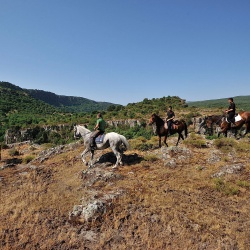

VIVA - New Active Tourism Itineraries in Villanova
Main sections of the site and Thematic sites
Main navigation

The paths of the Lake
Along the shores of the lake: from the medieval settlement of Curos to the templar Church of Santa Maria de S’Ispidale, through the necropolis of Puttu Codinu.
Technical info
Type
A pathway of historical and panoramic interest.
Degree of difficulty
Low difficulty route on easy terrain.
Time required
About 4 or 8 hours.
Practicability
Bicycle route.
Departure
Info point in Monteleone Rocca Doria, Via Sant’Antonio.
Description
For lovers of sport activities on the water, along the shores of the lake, in the portion of land belonging to the municipality of Monteleone Roccadoria, it is possible to enjoy activities such as canoeing, fishing and admire the striking features of the landscape characterised by amazing examples of vegetation and plant life and remarkable geomorphological formations, as well as by particular anthropic artefacts such as Cantoniera of Reinamare, dating back to the twentieth century, with two fountains made of red trachyte on the shores of the lake. The lake is accessible from the S.S. 292 near the junction for the town. Not far away, on the opposite side of the highway, there is a small menhir, 1.5 m high, hidden by the forest among the branches of the oaks.
Taking the S.S. 292, towards Villanova Monteleone, it is possible to see the medieval settlement of Curos thanks to the remains of the Shrine of Santa Maria of Curos, which is characterised by various inscriptions and graffiti.
The site can be reached by crossing the bridge over Lake Temo and taking a path immediately on the left that, after a few hundred meters leads to the ruins of the church. Proceeding towards Villanova Monteleone, on the same road and at a short distance, it is possible to see, at the right side of the entrance to access the prehistoric Necropolis of Puttu Codinu, a complex that includes nine groups of Domus de Janas dug into the white rock of a calcareous block.
Turning back towards Padria, after about 7 km, turn left towards Romana: after traveling 1 km, leave the main road to take a dirt road that leads to the country Church of Santa Maria de S’Ispidale or Madonna della Salute perhaps of Templar origin. Adjacent to the church is a stone churchyard, near the megalithic remains of a religious building characterised by a rectangular plan probably dating back to the Nuragic era. Proceeding along the same road, on the left side just before the intersection with the S.P. 28bis, it is possible to see the white nuraghe Pibirra with intact tholos.





